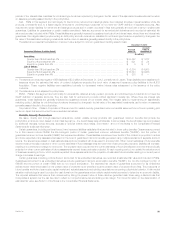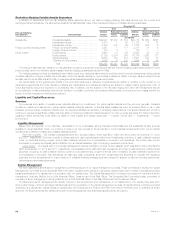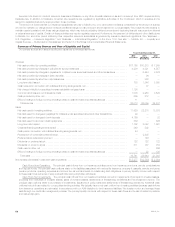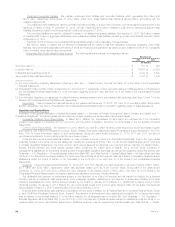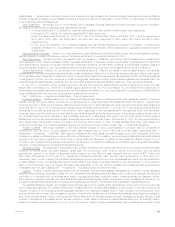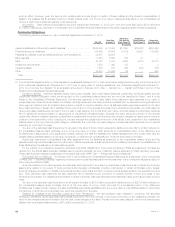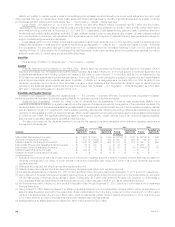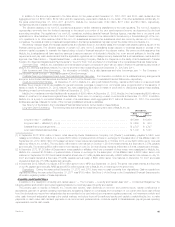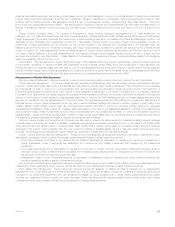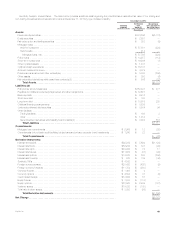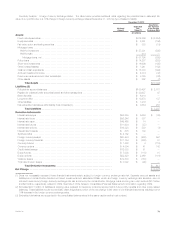MetLife 2012 Annual Report Download - page 67
Download and view the complete annual report
Please find page 67 of the 2012 MetLife annual report below. You can navigate through the pages in the report by either clicking on the pages listed below, or by using the keyword search tool below to find specific information within the annual report.
Bank Deposits. Bank deposits of $6.5 billion exceed the amount on the balance sheet of $6.4 billion due to the inclusion of estimated interest
payments through the stated contractual terms to the depositor, and have not been reduced or otherwise adjusted as a result of the closing of the
sale of the depository business on January 11, 2013. See Note 3 of the Notes to the Consolidated Financial Statements. Liquid deposits, including
demand deposit accounts, money market accounts and savings accounts, are assumed to mature at carrying value within one year. Certificates of
deposit are assumed to pay all interest and principal at maturity.
Debt. Amounts presented in the table for debt include short-term debt, long-term debt, collateral financing arrangements and junior
subordinated debt securities, the total of which differs from the total of the corresponding amounts presented on the consolidated balance sheet
due to the following: (i) the amounts presented herein do not include premiums or discounts upon issuance or purchase accounting fair value
adjustments; (ii) the amounts presented herein include future interest on such obligations for the period from January 1, 2013 through maturity; and
(iii) the amounts presented herein do not include $2.5 billion at December 31, 2012 of long-term debt relating to CSEs as such debt does not
represent our contractual obligations. Future interest on variable rate debt was computed using prevailing rates at December 31, 2012 and, as such,
does not consider the impact of future rate movements. Future interest on fixed rate debt was computed using the stated rate on the obligations for
the period from January 1, 2013 through maturity, except with respect to junior subordinated debt which was computed using the stated rates
through the scheduled redemption dates as it is our expectation that such obligations will be redeemed at that time. Inclusion of interest payments
on junior subordinated debt securities through the final maturity dates would increase the contractual obligation by $7.7 billion. Amounts presented
include payments under capital lease obligations of $3 million, $3 million, $1 million and $26 million, in the one year or less, more than one year to
three years, more than three years to five years and more than five years categories, respectively. Pursuant to collateral financing arrangements,
MetLife, Inc. may be required to deliver cash or pledge collateral to the respective unaffiliated financial institutions. See Note 13 of the Notes to the
Consolidated Financial Statements.
Investment Commitments. To enhance the return on our investment portfolio, we commit to lend funds under mortgage loans, bank credit
facilities, bridge loans and private corporate bond investments and we commit to fund partnership investments. In the table, the timing of the funding
of mortgage loans and private corporate bond investments is based on the expiration dates of the corresponding commitments. As it relates to
commitments to fund partnerships and bank credit facilities, we anticipate that these amounts could be invested any time over the next five years;
however, as the timing of the fulfillment of the obligation cannot be predicted, such obligations are presented in the one year or less category in the
table. Commitments to fund bridge loans are short-term obligations and, as a result, are presented in the one year or less category in the table. See
Note 21 of the Notes to the Consolidated Financial Statements and “— Off-Balance Sheet Arrangements.”
Operating Leases. As a lessee, we have various operating leases, primarily for office space. Contractual provisions exist that could increase or
accelerate those lease obligations presented, including various leases with early buyouts and/or escalation clauses. However, the impact of any
such transactions would not be material to our financial position or results of operations. See Note 21 of the Notes to the Consolidated Financial
Statements.
Other. Other obligations presented in the table are principally comprised of amounts due under reinsurance agreements, payables related to
securities purchased but not yet settled, securities sold short, accrued interest on debt obligations, estimated fair value of derivative obligations,
deferred compensation arrangements, guaranty liabilities, the estimated fair value of forward stock purchase contracts, and general accruals and
accounts payable due under contractual obligations, which are all reported in other liabilities on the consolidated balance sheets. If the timing of any
of these other obligations is sufficiently uncertain, the amounts are included within the one year or less category. Items reported in other liabilities on
the consolidated balance sheets that were excluded from the table represent accounting conventions or are not liabilities due under contractual
obligations. Unrecognized tax benefits and related accrued interest of $708 million and $237 million, respectively, was excluded from the table as
the timing of payment cannot be reliably determined.
Separate account liabilities are excluded from the table. Generally, the separate account owner, rather than the Company, bears the investment risk
of these funds. The separate account assets are legally segregated and are not subject to the claims that arise out of any of our other businesses. Net
deposits, net investment income and realized and unrealized capital gains and losses on the separate accounts are fully offset by corresponding
amounts credited to contractholders whose liability is reflected with the separate account liabilities. Separate account liabilities are fully funded by cash
flows from the corresponding separate account assets and are set equal to the estimated fair value of separate account assets.
We also enter into agreements to purchase goods and services in the normal course of business; however, these purchase obligations were not
material to our consolidated results of operations or financial position at December 31, 2012.
Additionally, we have agreements in place for services we conduct, generally at cost, between subsidiaries relating to insurance, reinsurance, loans
and capitalization. Intercompany transactions have been eliminated in consolidation. Intercompany transactions among insurance subsidiaries and
affiliates have been approved by the appropriate insurance regulators as required.
MetLife, Inc.
Liquidity Management and Capital Management
Liquidity and capital are managed to preserve stable, reliable and cost-effective sources of cash to meet all current and future financial obligations
and are provided by a variety of sources, including a portfolio of liquid assets, a diversified mix of short- and long-term funding sources from the
wholesale financial markets and the ability to borrow through credit and committed facilities. Liquidity is monitored through the use of internal liquidity risk
metrics, including the composition and level of the liquid asset portfolio, timing differences in short-term cash flow obligations, access to the financial
markets for capital and debt transactions and exposure to contingent draws on MetLife, Inc.’s liquidity. MetLife, Inc. is an active participant in the global
financial markets through which it obtains a significant amount of funding. These markets, which serve as cost-effective sources of funds, are critical
components of MetLife, Inc.’s liquidity and capital management. Decisions to access these markets are based upon relative costs, prospective views of
balance sheet growth and a targeted liquidity profile and capital structure. A disruption in the financial markets could limit MetLife, Inc.’s accessto
liquidity.
MetLife, Inc. 61


